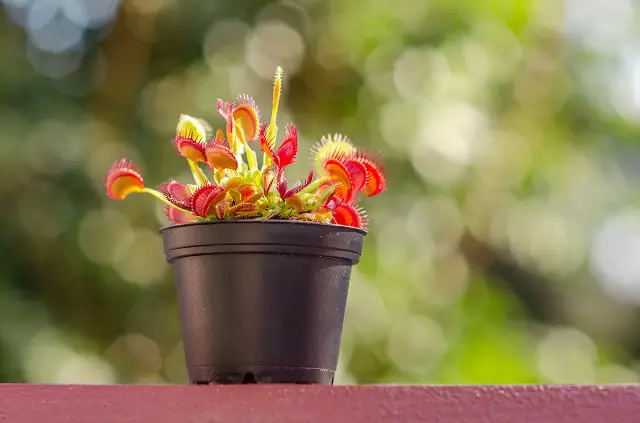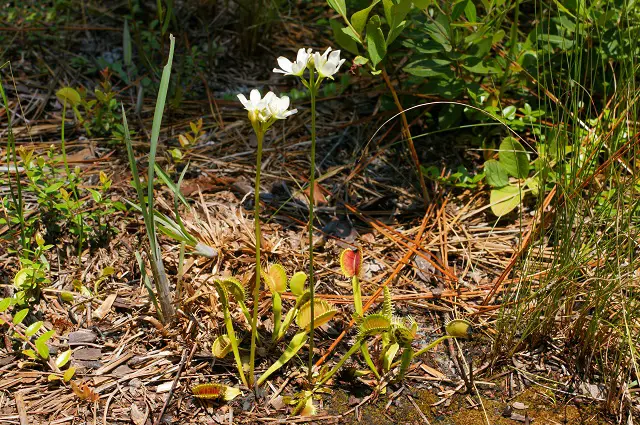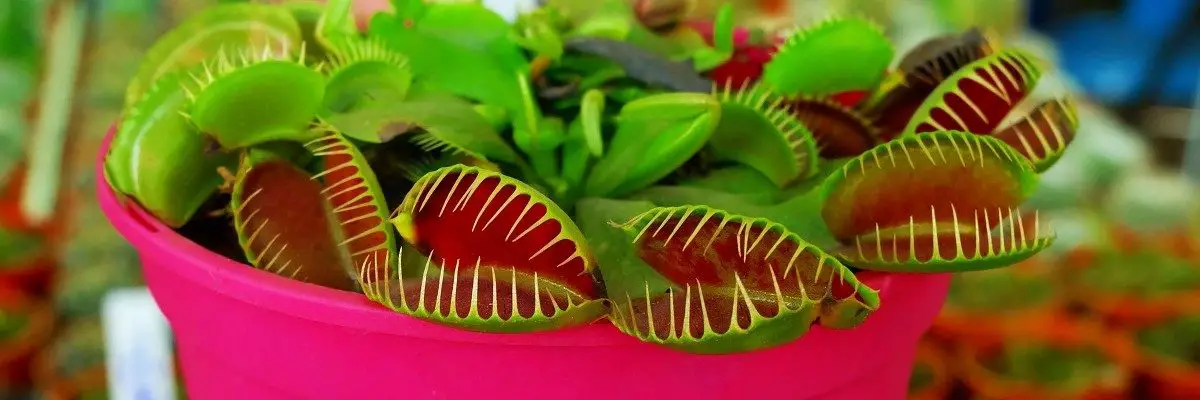A mild acidic, moist soil is needed for the Venus flytrap. Growing a Venus flytrap in sand and peat moss is much easier, providing a small amount of acidity and keeping soil from being too wet. Venus flytraps require temperatures between 70 and 75 degrees Fahrenheit during the daytime and humidity of at least 60 percent. The Venus flytrap should not be allowed to drop below 55 degrees F (13 degrees Celsius) during the night. Choosing distilled or bottled water is preferred for the Venus flytrap because it can have an acute reaction to chemicals and minerals found in tap water. For moist soil, soak the plant in a water dish for one hour and try not to get the foliage wet.
| Steps For Growing Your Venus Fly Trap |
|---|
| 1. The Venus Flytrap should be placed in a pot up to twice its size. These plants immediately prefer humidity around them, and the larger the pot, the more potential humidity. Fill the growing pot with soil containing low levels of nutrients, such as sphagnum moss mix and sand 1:1 ratio. You should position it in a protected area with good lighting and ideally four hours of direct sunlight daily. You may want to consider using a window sill in the kitchen or bathroom, with the added benefit of humidity. |
| 2. Mix a few Water Storage Crystals into the growing pot to further assist with soil moisture retention. |
| 3. Ensure that the roots are not disturbed by removing the plant from its container. |
| 4. Replant the plant in the hole and lightly firm down the soil. Water thoroughly, but allow the soil to drain. |
| 5. As the plants enter dormancy over the winter, move them to a sheltered location. During this time, watering should be reduced (just enough to keep the soil moist). |
Make the Venus flytrap a terrarium if you wish to make its care easier. Plants can catch insects that fly around inside, and it also maintains humidity and moisture for a longer period of time. An old fish tank can be used to house the plant if it is covered. Sphagnum moss mixed with sand is used in the lining. Alternatively, the Venus flytrap may be placed on a window if it faces toward the light. Terrariums have several drawbacks also, including drainage and heat build-up.
Venus Flytraps In Winter
The Venus flytrap blooms in the spring, grow in the summer and fall, and goes dormant in the winter (about 3-5 months). Although it may appear that they die in the winter, they don’t. In order to save energy for the next season, they don’t try as hard to grow as much and slow down.
However, this does not mean you should ignore them. Photosynthetic organisms still require sunlight and water to function. Follow these tips to ensure your plants survive the winter:
| Make sure to plant Venus flytraps in acidic, sandy soil. Keeping them outdoors is the best option, but ensure you don’t live in an area susceptible to freezing and frost. If you have potted plants, move them into the ground, where the soil volume will provide insulation to protect the rhizomes from freezing. |
| Water the soil sparingly, but keep it moist. Water will still be needed, but not as much as before. |
| Let them get some sun, but not as much as usual. Winter dormancy occurs when temperatures drop and daylight hours decrease (shorter days). The light should be reduced to less than 12 hours per day during the winter. |
What Should I Feed a Venus Flytrap?
The chances are they can catch prey on their own if you grow them outdoors. Occasionally feeding them small insects is an excellent way to keep them healthy, particularly when growing them indoors.
Ideally, it would be best if you fed them live insects to trigger their digestion, as the urea released by the insect tells the plant to release digestive enzymes. The only problem is that it can be difficult to feed live insects, which may not be necessary. It is perfectly acceptable to give them dead insects instead.
Some people add chicken bouillon or another type of protein to the water, which can cause mold and bacteria, so should be avoided.

How Long Does It Take To Grow A Venus Flytrap
It takes only 10-14 days for the Venus flytrap seeds to germinate. However, you will need patience since the venus flytrap takes time to grow. When fully grown, the plant can reach a height of 3-6 inches and a diameter of about 5 inches at full maturity.
Can You Grow A Venus Flytrap In Water
The Venus Flytrap can also be grown in a pond or fountain, as long as the plant’s crown is kept above the water. You should not plant it directly in the ground due to its specific soil requirements unless you are creating a specific type of bog garden.
Can You Grow A Venus Flytrap In Winter
Autumn marks the beginning of the Venus Flytrap’s dormant period. Dormancy is a sort of rest or sleep during which the growth of a plant slows and eventually stops. During the low temperatures, short days, and lack of insects to feed on in the winter months, a period of dormancy is essential for the plant’s long-term health to replenish its stored energy and reset the biological processes.
Can You Grow A Venus Flytrap From Seed
Yes, you can. In order for seeds to germinate and grow properly, a few conditions must be met for them to grow optimally. Venus Flytrap blooming and the seed-producing season typically occurs between April and June in the northern hemisphere. That means a new batch of seeds should be ready by the end of June or the beginning of July. For at least a year after harvest, seeds stored properly in a refrigerator will germinate well. Germination rates can even be high years after seeds are stored in a refrigerator.
Should You Remove Black Leaves From Venus Flytrap?
You know you’re going to encounter dead leaves fairly frequently if you own a Venus flytrap. If this happens, you have the option of pruning the plant. Pruning is possible with Venus flytraps. Trimming is not necessary for a plant’s survival despite providing health and aesthetic benefits. Be careful with the healthy leaves around the bulb and use thin, sharp scissors to cut the dead leaves.
Where Do Venus Flytraps Grow Best?
Flytraps are best grown outside in containers or pots. A sunny deck or patio is a perfect setting for them. It can also be grown in a pond or fountain as long as its crown remains above water. Unless you have created a specially designed bog garden, avoid planting this in the ground due to its specific soil needs.

Can You Grow A Venus Flytrap In A Terrarium?
Contrary to popular belief, the Venus flytrap does not thrive in high-humidity environments. While some moisture is okay, we must compare their original habitat to what we want them to live in a terrarium. The grasslands and savannahs in which flytrap flourishes are open and sunny. Glass enclosures won’t provide enough aeration for a flytrap’s root system, and drainage and heat will become an issue.


